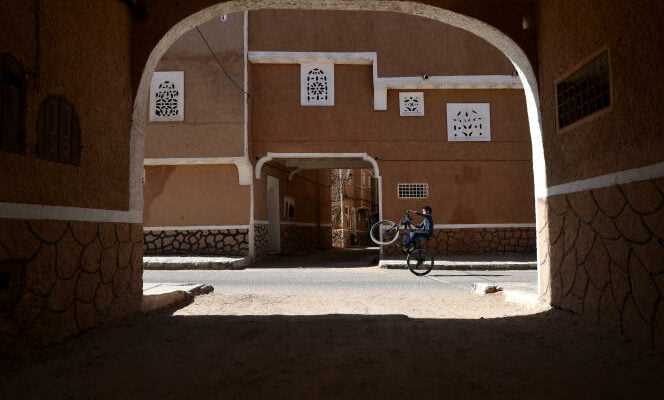To not miss any African news, subscribe to the “Monde Afrique” newsletter from this link. Every Saturday at 6 am, find a week of news and debates treated by the editorial staff of “Monde Afrique”.
On the place of the souk, the market of Ghardaïa, the negotiations are going well for the acquisition of local products, in particular the wool carpets made by hand by the women of the region. Tourists, who come from Algiers, Oran or even Annaba, already wear the chèche, a long scarf typical of the southern regions, to protect themselves from the sun.
They drove several hours or took one of the flights chartered by the national company Air Algérie to get to this city in the northern Sahara known for its palm groves and its five ksour, these fortified cities where the Berber-speaking community of Mozabites lives. .
“Usually we go to Europe, but it was too expensive and restrictive due to the limited number of flights and the Covid”, explains Lina, a teacher from the Algiers suburbs. She and her husband came to spend their holidays in Ghardaïa, in the Mzab valley, 600 kilometers south of Algiers.
“Here, the tourist season begins in October and ends around April”, says Anas, a resident. During the high season, this 26-year-old architecture graduate becomes a tourist guide for “northerners” to whom he makes discover this region classified as world heritage by Unesco since 1982. Proof of the success he meets, his telephone does not stop ringing. At the other end of the line, travel agencies in the north ask him to find last-minute accommodation for desperate travelers.
“The Adventure”
In Algeria, where the revival – regularly announced – of the tourism sector is akin to wishful thinking, more than two million nationals are in the habit of going to Tunisia every year to spend their holidays there. But, since the health crisis, the land border with the eastern neighbor – through which 90% of the tourist flow passed – has been closed. It was partially reopened on January 5, but only for residents. Europe and Turkey, two other popular destinations, have also become more difficult to access.
So, like Lina and her husband, many middle-class Algerians turned to the local offer, in the southern desert, but also in the mountains in the east of the country. Not without creating some difficulties, because while some have organized their stay themselves, others have gone through agencies that are not always in order.
The drop in activity due to Covid-19 has led to the temporary or permanent closure of well-established travel agencies, which has benefited “to certain parasitic organizations”, deplores Saïd Boukhelifa, president of the National Union of Tourist Agencies (SNAT). ” Some are doing not too badly but, for the majority, it’s adventure: they rent a coach, take a guide and head towards Tikjda and Djurdjura [région montagneuse du nord-est du pays] or to the south, especially in Taghit », he explains.
This small oasis in the region of Béchar (southwest) – which should not receive more than 1,000 tourists at a time, according to Mr. Boukhelifa – is regularly at the center of controversy because of the degradation of ancient rock engravings and the pollution of the places due to the influx of summer visitors.
Overwhelmed by the influx of visitors
During New Year’s Eve 2022, thousands of people converged on the great dune of Taghit, a majestic site overlooking the palm grove, set off fireworks and left their waste in the sand. “It has been three consecutive years that we have witnessed an ecological massacre. The state must regulate access to these sites., denounces the president of the SNAT.
The city of Ghardaïa, where customs and lifestyles have been preserved for centuries, has not experienced this problem. Visits to the five fortified cities are strictly regulated. At the entrance to each of them, an association office run by residents forms small groups of tourists and provides them with a member of the Mozabite community responsible for directing them through the narrow streets.
The same strict framework inside the old town where it is forbidden to smoke and to photograph the inhabitants without their authorization, in particular the women who appear furtively draped in their haik, a long white woolen cloth which reveals a single eye.
But during these end-of-year holidays, local associations were quickly overwhelmed by the influx of visitors, explains Anas. “It was unheard of. They were forced to form groups of more than twenty people, which is unusual for the place. After two years of emptiness because of the Covid, it feels good to see Ghardaïa lively and it’s good for the local economy”, rejoices the young man.
On the scale of the country, this influx of national tourists is however ” very relative”, to care about nuance Saïd Boukhelifa. While hotel capacities have increased in urban areas, they remain very limited in areas where tourism is seasonal, with “less than 2,000 beds in the mountains and 8,000 beds in the south”, he specifies. Not enough to properly accommodate all nationals or foreign tourists, only “5,000 to visit the country annually”, regrets this former executive of the Algerian National Tourist Office (ONAT).
